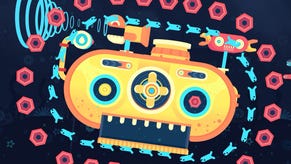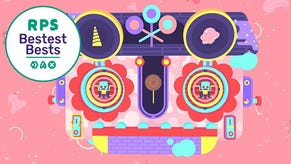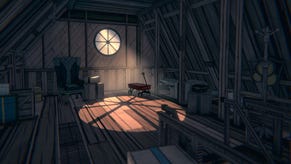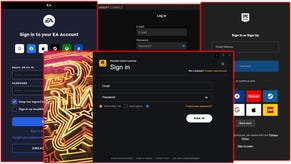Interview: Gnah! A Windosill-Inspired Game About Heads
Hands On Faces
I was in love with Gnah! the second I saw it. Each of this puzzle game's levels is a hollow head drawn and modelled in a crisp, graphic style. When you sit down to play it, your objective isn't explicitly stated, and so you just start to spin it around and poke at it. Twirl this cog to make its eyes open, angle this search light to make screens light up inside, twist this nodule to let the water in. By experimenting with each level-headed toy, you discover its logic and unlock progress to the next. There was some non-euclidean trickery in the build I played, but otherwise it's a gentle experience, more interested in the delight and discovery of playing with heads than in making you scratch your own.
To find out more about the game I spoke to Samuel Boucher, Saleem Dabbous and Nick Rudzicz from developers KO-OP MODE about how each level begins as a 2D concept, the tragedy of each Gnah head, and the inspiration they've drawn from Windosill and Polly Pockets.
RPS: Each of Gnah!'s levels begin as 2D designs and then are turned into 3D. Can you talk through how that works, and why you build the levels this way?
Sam: I come from a 2D art world and never really managed to properly learn 3D, so I’m making everything in 2D as concepts. After I’m pleased with the 2D version I work closely with my friend Yan to translate it into a 3D model. After we have that 3D model, I keep adding details inside -- textures and other elements that could fill the space that I can’t picture in the 2D concepts. So it’s really a back and forth with Yan to make it look perfect.
RPS: How do you design the puzzles? Do they come after the art design, or during? Are they also designed collaboratively?
Sam: It’s an organic process really: sometimes I just start with an idea of visuals that I want to see and the puzzle comes after; and sometimes I just want to play with a certain puzzle or mechanic I have in mind, and I have to join a theme and some art to it after. It can go both ways.
We all have ideas we want to try to, so it’s not always me. For example, Nick wants to work on a space themed Gnah, so he’s brainstorming ideas on his side.
Saleem Dabbous: Sometimes a concept or theme lends itself to an obvious jumping point for a puzzle, but every single design we’ve come up with has gone through an iterative process of redesign until we feel like we have the right balance between playfulness, puzzle, and atmosphere. The fact that each GNAH can be its own unique thing means that we all bring some form of idea or inspiration to the table. Each of those ideas then get filtered through Sam’s creative process and turned into something really cool.
RPS: The original idea had a character on the inside that you were controlling. Why did you decide to remove that and focus just on disembodied clicking?
Sam: In testing the game we found that the back and forth with two gameplay styles didn’t really work. The character was breaking the nice gameplay of manipulating stuff in the head itself. Also, after interacting with details on the exterior, people tried to interact with the same stuff from the inside and couldn’t because they were controlling the character. We got around that problem by removing the Kid entirely -- but that doesn’t mean s/he won’t reappear in the game :)
Nick Rudzicz: Yeah, that’s sort of a two-fold story. On the one hand, there’s a purely technical constraint. As Sam pointed out, he does all his designing in 2D; we then wait for Yan -- who has a full-time day job -- to convert those designs to 3D; then, for a while, we had a contractor, Nadia, work on animating the models, which would then come to me for programming/scripting. But as we evolved and iterated upon the puzzles, we’d often have to go all the way back through that chain to modify the levels, change character animations, taking much longer than it should. And then Nadia’s contract finished while we still had a lot of stuff we wanted to do with the character, so that was that.
Secondly, as Sam was hinting, we had a sort of internalised constraint that only the Kid could interact with the inside of the gnahs; and only the player could interact with the faces. This distinction came off in playtests as completely arbitrary -- everyone wanted to click on everything, regardless of what side they were on! We decided to simplify the interaction language: the gnahs are inspired by toys, after all, so we might as well let the players explore the whole range of bits and bobs in each one.
RPS: Now there's no character, is there a plot or story that links together each level, or is it purely an abstract game?
Sam: It’s meant to be “abstract” in a sense that you have to find the meaning of all this, there’s no obvious storyline. You just have to explore and find objects, maps, or drawings that will give you some hints during the game.
Nick: The gnahs do come from a distinct universe and have their unique history, which we’ll be exploring in a bit more depth as more and more levels come together. This might be the wine talking, but Sam’s art always gave me this Shadow of the Colossus vibe; the cold eyes gave me the sense of these pathetic machinethings with just enough consciousness to know their own tragic place in the world. We...may not go in that direction, but I think there’s certainly a consistent enough style in his art to inspire a certain level of world-building.
Saleem: There’s definitely an overarching connection between all the levels and monsters in the game. How deep we explore that is still a topic of conversation between us.
RPS: Right now the three levels in the demo build are solved through experimentally prodding at the environments. I found it quite sedate; poking, seeing what happens, poking again. Was that your aim, or is that more down to these being earlier introductory levels? Do you plan to add new mechanics or twists in future levels?
Sam: Each Gnah will be different. We’ll combine mechanics, add new ones and distort them, play with them. But yes, the main feeling we want is a slow-paced exploration of a strange toy, while surprising the player with unexpected things hidden in those interactions.
RPS: What games have inspired your design, and what artists have inspired the look of the game?
Sam: Keita Takahashi is my main inspiration in “the game world”. I really like the playfulness and very ludic sensibility he has. Friendswithyou is an art collective that really inspires me visually and conceptually, too, and finally, I love Windosill for it’s pure, simple aesthetics and it’s weird and interesting interactions.
Nick: Yeah, we refer back to Windosill quite a bit internally -- it’s got this amazing tactility and squishiness that I really want to try to capture. We’ve also gotten a few (flattering) comparisons to Fez -- is Ninety-Degree Flippers a genre yet? -- and I think for us it’s important to capture that feeling of safe and whimsical and wonder-ful exploration of a pretty alien world.
Saleem: Things like Polly Pocket and Mighty Max toys have a strong influence over the design of micro-worlds within the monsters. Toys have this amazing ability to incite world building inside a kid’s head, and we really want each Gnah to have that same feeling - consistent aesthetics, but each one a unique world.
RPS: The game is due out in 2015. What will you be working on between now and then?
Sam: On everything! We want a lot of these weird heads. We have them conceptually but we need to design them, model them, add the music and some code, etc... So yeah a lot of work ahead of us!
Saleem: Yeah a game like GNAH! lives or dies based on its ability to surprise and delight, getting each monster alive and full of playful interactions is something we really want to get right.


















